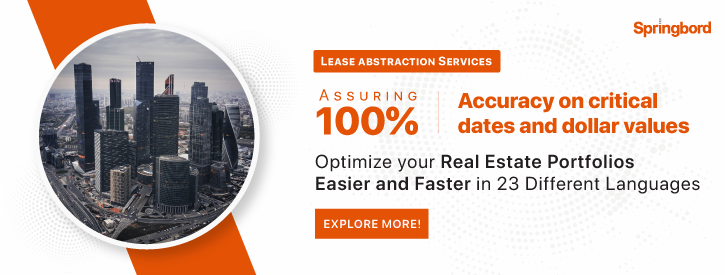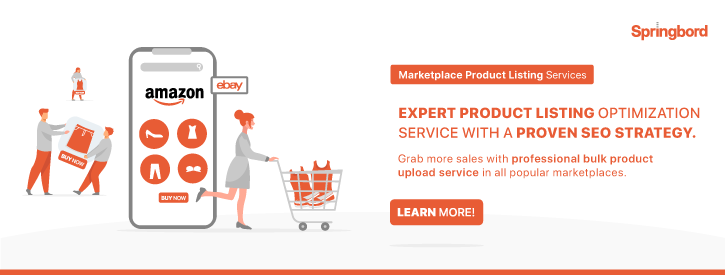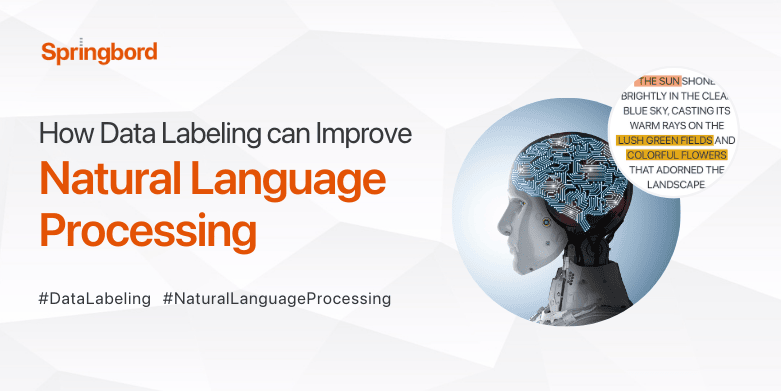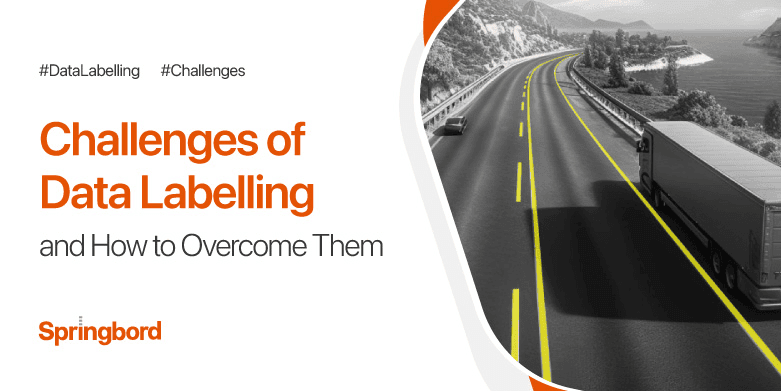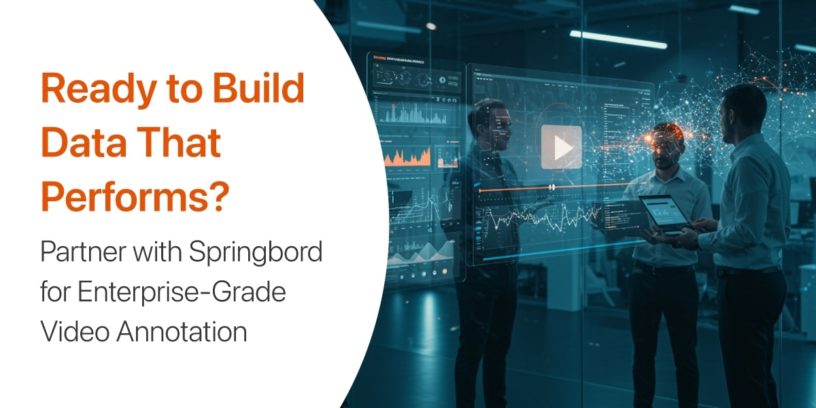 Read time 6 min
Read time 6 minComputer vision is no longer just a cutting-edge experiment; it’s now a core business tool. In 2025, the global market is expected to hit $27.02 billion, fueled by real-world use cases that improve speed, accuracy, and decision-making across industries.
From reducing product defects in manufacturing to preventing theft in retail and automating asset inspections in infrastructure, businesses are finding serious ROI in vision-powered systems. A recent industry report shows that 63% of companies using visual AI have already seen more than 10% gains in efficiency.
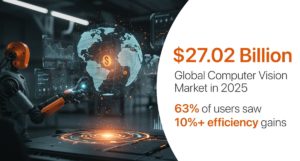
What’s different now? The tech is more mature, more accessible, and more integrated. Models can now run at the edge, require less training data, and plug right into existing workflows, thanks to innovations like vision transformers, few-shot learning, and multimodal AI.
At Springbord, we help businesses turn this technology into results, from custom vision systems and expert data labeling services that ensure high-quality training data, to end-to-end AI deployment.
Why Computer Vision is No Longer Optional in 2025
Computer vision (CV) has made a decisive leap from R&D labs to the operational core of enterprise systems. In 2025, it’s more than just a technological upgrade; it’s a business requirement. Three things are coming together to push businesses to adopt: technical maturity, infrastructure readiness, and regulatory pressure.
From Experiment to Infrastructure
A growing number of mid-to-large enterprises are embedding CV directly into mission-critical processes. According to Deloitte, over 65% of Fortune 500 companies now deploy computer vision in at least one core business function, up from just 24% in 2020. This shift reflects increasing confidence in the technology’s reliability and ROI.
Edge Computing and 5G: Real-Time is the New Standard
Real-time decision-making is no longer aspirational—it’s expected. Thanks to advances in edge computing and 5G, companies can now process video streams locally, reducing latency and cloud dependency.
Multimodal AI: Vision Meets Language
2025 also marks the mainstream adoption of multimodal AI systems that combine visual data with language models (LLMs) to extract richer insights. For instance, a safety violation detected on camera can now be paired with automated compliance reports generated in natural language. This feature unlocks a new layer of operational intelligence and reporting automation.
Compliance is Driving Adoption
The regulatory environment is another catalyst. Stricter enforcement of GDPR in the EU, OSHA safety mandates in the US, and ESG (Environmental, Social, Governance) reporting requirements globally are pushing businesses to adopt real-time monitoring solutions. CV systems are increasingly used for privacy-compliant surveillance, PPE detection, and environmental compliance auditing.
At Springbord, we’re helping organizations navigate this shift through tailored computer vision pipelines that are edge-ready, compliant with evolving regulations, and built for cross-modal intelligence. From automated labeling to deployment strategy, our services ensure that clients aren’t just keeping up—they’re staying ahead.
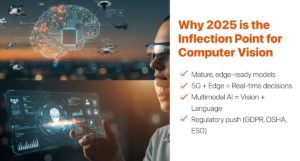
Top 5 Applications of Computer Vision in 2025
Computer vision is no longer a tool of experimentation; it’s a critical lever for operational efficiency, risk mitigation, and compliance across sectors. Here’s a deep dive into five high-impact applications that are reshaping enterprise workflows and bottom lines in 2025.
1. Automated Visual Inspection: Raising the Bar for Quality in 2025
Manual inspection is increasingly inadequate, slow, inconsistent, and costly. In 2025, Automated Visual Inspection (AVI), powered by advanced computer vision, is transforming quality control with real-time, high-precision defect detection across complex manufacturing lines.
A 2025 study shows that deep learning-based systems now achieve 98.5 %+ accuracy, cutting defect rates by up to 60% and increasing throughput by 5x. These results are driven by the rise of foundation models—large-scale vision AI pre-trained across domains and fine-tuned with minimal data. They handle low light, occlusion, and data scarcity more effectively than traditional rule-based systems.
Key applications include:
- Automotive: Weld and paint inspection
- Semiconductors: Crack and particle detection
- FMCG: Packaging integrity, label verification
- Wood & Furniture: Surface flaw detection
At Springbord, we deliver end-to-end AVI solutions—from model tuning and annotation to edge deployment, enabling faster, more scalable quality control systems tailored to your operational goals.
2. Vision-Powered Retail Intelligence: From Cameras to Conversion
Retailers lose millions annually to inventory errors and non-compliant merchandising. In 2025, computer vision systems deployed on edge cameras are closing this gap, converting in-store video into real-time retail intelligence.
Modern CV systems combine shelf analytics, pose detection, and demographic estimation, enabling automatic detection of out-of-stock items, customer dwell time, and heatmap-based layout optimization. A 2025 MDPI study reports 2–4% sales uplift and up to 25% reduction in compliance costs for retailers leveraging these systems.
Use cases include:
- Shelf audits for planogram compliance
- Customer journey mapping using anonymous pose tracking
- Targeted engagement via demographic-driven product placement
At Springbord, we integrate edge-compatible vision analytics into retail ecosystems, enabling clients to drive revenue and reduce operational friction through data-backed store optimization.
3. Vision for Autonomous Operations: Edge Intelligence Takes Flight
Manual surveying and delivery logistics are no longer scalable. In 2025, vision-enabled drones and robots, powered by real-time SLAM, object tracking, and AI path planning, are transforming inspection and logistics operations across industries.
In warehousing, vision-guided robotics is streamlining pick-and-place, pallet movement, and last-mile delivery with precision and low latency.
Key advancements include:
- Edge-optimised SLAM for fast localisation without GPS
- Vision-based path planning for dynamic environments
- Onboard object detection to avoid obstacles and recognise targets in real time
Use cases:
- Drone-based infrastructure inspections
- Smart warehouse automation
- AI-driven delivery bots in retail and logistics
At Springbord, we engineer autonomous vision systems that combine edge AI, robust SLAM, and tailored robotics workflows, empowering clients to scale operations while cutting costs and risks.
4. Multi-Camera Security & Threat Detection: AI for 24/7 Situational Awareness
Human surveillance is restricted by fatigue and field of vision. In 2025, AI-driven multi-camera systems using real-time person re-identification (ReID), anomaly detection, and crowd analysis are transforming threat detection into a proactive, precision-driven capability.
Recent academic findings confirm that multi-view person ReID systems now exceed 90% tracking accuracy in large-scale public settings, even under occlusion or low light. Combined with AI-based anomaly detection, this enables security operations to cut incident response times by over 80% while maintaining real-time coverage across complex environments.
Technical upgrades include:
- Cross-camera ReID models trained with synthetic occlusion data
- Edge-based anomaly detection to reduce latency and bandwidth
- Density heatmaps for crowd flow prediction and escalation prevention
Key deployments:
- Smart cities: Real-time monitoring of public transit, streets, and events
- Airports: Coordinated surveillance for unattended objects or erratic behavior
- Banking: ATMs and branch locations that automatically spot fraud
Springbord enables clients to deploy and scale AI-first security infrastructures, integrating real-time video analytics, federated surveillance models, and adaptive alerting—unlocking safety and operational insight across high-risk environments.
5. AI-Powered Document Vision & Compliance: Going Beyond OCR in 2025
Industries like insurance, finance, and healthcare still rely heavily on manual document reviews, leading to bottlenecks, errors, and compliance risks. In 2025, vision transformers are redefining document automation, extracting contextual meaning, not just text.
Unlike legacy OCR, modern models like LayoutLMv3 and DocFormer interpret spatial and semantic relationships across scanned forms, handwritten notes, and embedded images. According to a 2025 Springer study, these models reduce document processing time by 50–80%, while increasing field-level extraction accuracy to over 94%.
Key applications:
- Insurance: Validate claims by linking form fields to visual proof
- Finance: Real-time KYC verification and fraud detection
- Healthcare: Parse medical forms, prescriptions, and diagnostics at scale
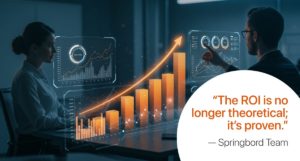
Springbord builds tailored document vision pipelines integrating pre-trained transformers, custom entity extraction, and audit-traceable workflows, so your compliance burden becomes a competitive advantage.
Conclusion
Computer vision has crossed the threshold from innovation to essential enterprise. Whether it’s powering autonomous inspections, streamlining retail intelligence, enhancing security, or automating document workflows, the ROI is no longer theoretical; it’s proven.
In 2025, the companies that lead in vision AI are not just more efficient; they’re safer, faster, and better positioned to scale in an increasingly data-driven economy.
At Springbord, we don’t just set up computer vision; we make it work. From precision data labeling and annotation to model development, edge deployment, and compliance integration, we build custom CV solutions that deliver measurable impact.
Let us help you make business-helping vision systems. Talk to us today.
FAQ
1. What industries benefit most from computer vision in 2025?
Manufacturing, retail, logistics, security, and finance benefit the most. They use computer vision to boost efficiency, reduce errors, and cut costs.
2. What advances have made computer vision more accessible?
Edge computing, 5G, and foundation AI models now make computer vision faster, cheaper, and easier to integrate.
3. How does computer vision help with compliance?
It automates monitoring and document review, making it easy to stay compliant with regulations like GDPR, OSHA, and ESG.
4. What’s the difference between traditional machine vision and modern computer vision?
Traditional systems used fixed rules for simple tasks, while modern computer vision uses deep learning to understand complex environments.
5. Will computer vision replace human inspection completely?
No, it supports and augments human work, making inspections faster and more accurate rather than replacing people.
6. How does computer vision work with other AI technologies?
It combines with language models, analytics, and robotics for intelligent end-to-end automation across industries.
7. What should businesses consider when implementing computer vision?
Focus on data quality, edge infrastructure, privacy regulations, and selecting a skilled partner for tailored deployment and ongoing support.



